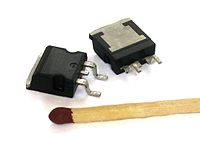
Photo from wikipedia
Abstract This work presents the effect of varied thickness of oxide layer and radiation dose on electrical characteristics of Ag/SiO2/Si MOS devices irradiated by 1.5 MeV γ–radiations of varied doses. SiO2… Click to show full abstract
Abstract This work presents the effect of varied thickness of oxide layer and radiation dose on electrical characteristics of Ag/SiO2/Si MOS devices irradiated by 1.5 MeV γ–radiations of varied doses. SiO2 layers of 50, 100, 150 and 200 nm thickness were grown on Si substrates using dry oxidation and exposed to radiation doses of 1, 10 and 100 kGy. The exposure to radiation resulted in generation of fixed charge centers and interface traps in the SiO2 and at the Si/SiO2 interface. Capacitance-conductance-voltage (C-G-V) and capacitance-conductance-frequency (C-G-f) measurements were performed at room temperature for all MOS devices to quantify the active traps and their lifetimes. It is shown that accumulation and minimum capacitances decreased as the thickness of SiO2 layer increased. For the unexposed MOS devices, the flat band voltage VFB decreased at a rate of −0.12 V/nm, density of active traps increased by 4.5 times and depletion capacitance CDP, increased by 2.5 times with the increase of oxide layer thickness from 50 to 200 nm. The density of active traps showed strong dependence on the frequency of the applied signal and the thickness of the oxide layer. The MOS device with 200 nm thick oxide layer irradiated with 100 kGy showed density of active interface traps was high at 50 kHz and was 3.6×1010 eV−1 cm−2. The relaxation time of the interface traps also increased with the exposure of γ–radiation and reached to 9.8 µs at 32 kHz in 200 nm thick oxide MOS device exposed with a dose of 100 kGy. It was inferred that this was due to formation of continuum energy states within the band gap and activation of these defects depended on the thickness of oxide layer, applied reverse bias and the working frequency. The present study highlighted the role of thickness of oxide layer in radiation hard environments and that only at high frequency, radiation induced traps remain passivated due to long relaxation times.
Journal Title: Materials Science in Semiconductor Processing
Year Published: 2017
Link to full text (if available)
Share on Social Media: Sign Up to like & get
recommendations!